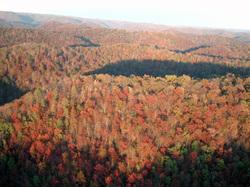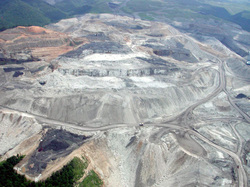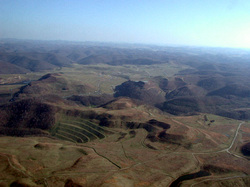
As you can see from my picture, the march on Blair Mountain was both exhausting and exhilarating. Friends have asked questions about the march and issues related to it, so I have tried to continue my own education.
For example, I have been learning more about what the process of mountain top removal (MTR) actually involves - how it is done and what happens to the nearby environment and people during and after the MTR. There are several steps to the MTR process:
- clearing all topsoil and plants - that alone sounds painful and bleak
- blasting through 500-800 feet of mountain surface to reach the seam of coal
- digging and removing coal and debris with a huge machine which actually does the work that in the past was done by people
- dumping waste, known as overburden or spoil, into valleys and stream beds - typically filling or burying the streams
- processing - or washing and treating - the coal, creating waste water, known as slurry or sludge, which is then stored in impoundments that are often open, poorly supported and unstable ... slurry is made of a mixture of water, coal dust, clay, and toxic chemicals including arsenic, mercury, lead, copper, and chromium
- reclamation which is supposed to involve stabilization of the land and revegetation ... a not very closely monitored or regulated process
What are the effects of this devastation, really?
The drastic changes to the landscape increase flooding (which includes runoff that contains toxic chemicals). The ongoing blasting associated with MTR damages the foundations of homes, property values, and quality of life. Blasting also randomly sends boulders and debris down onto yards in the communities below the MTR sites, creating safety risks. Slurry and sludge poison drinking water and increase realities of disease in nearby communities. These are immediate and short-term changes.
Let's look to the past, then far into the future. In 2009, the Smithsonian Magazine reported that...
Since the mid-1990s, coal companies have pulverized Appalachian mountaintops in West Virginia, Kentucky, Virginia and Tennessee. Peaks formed hundreds of millions of years ago are obliterated in months. Forests that survived the last ice age are chopped down and burned. The Environmental Protection Agency estimates that by 2012, two decades of mountaintop removal will have destroyed or degraded 11.5 percent of the forests in those four states, an area larger than Delaware. Rubble and waste will have buried more than 1,000 miles of streams.
The rate and scope of this destruction is incredibly short-sighted. Centuries of work by Mother Earth gone and, on top of that, toxic substances introduced into what is left. Without extensive intervention, this threatens much needed biodiversity (all of life is interconnected and interdependent for survival) and causes harm to the health and well-being of plants, humans, and other animals for hundreds of years to come.
And no intervention can truly re-create what has been destroyed - particularly the culture of the mountain people in the communities affected by MTR. I witnessed the strength and integrity of the people from Appalachia at the march - outspoken, impassioned, but respectful and honest.
Hazel Dickens fought MTR - she was one beautiful voice rising from Appalachia. She was to have performed at the Blair Mountain March but, sadly, passed away in April before the March.





 RSS Feed
RSS Feed
